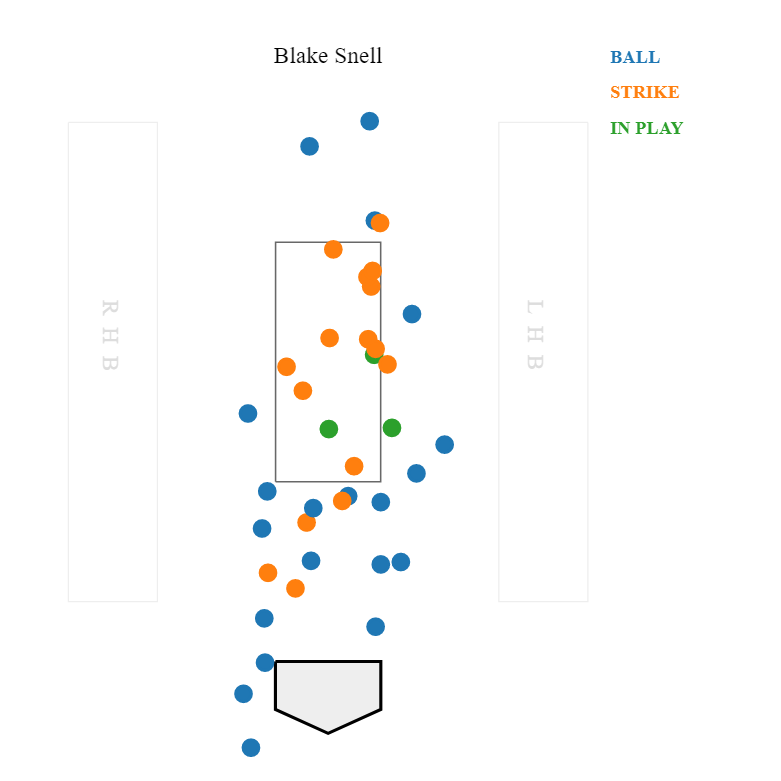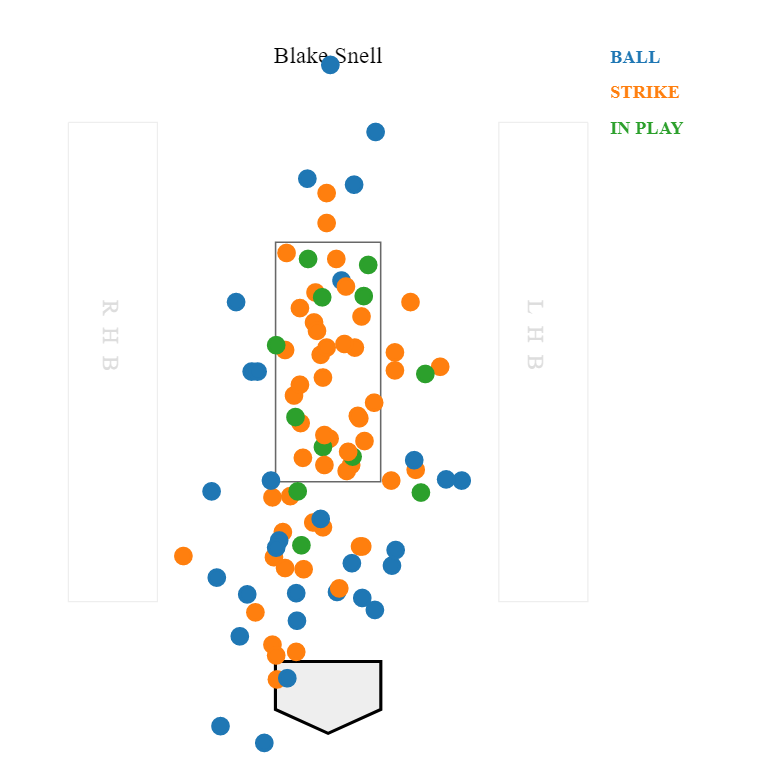Nothing Is Wrong With Blake Snell
There is no getting around the fact that Blake Snell had a miserable, short outing against the Yankees on Wednesday afternoon. He had little control and wasn’t fooling any of the hitters he faced. I do give Gary Sanchez credit for hitting an outside changeup for an opposite-field home run, and the weak grounder DJ LeMahieu hit for a leadoff single had just a 23 percent chance of becoming a hit (per Baseball Savant). Still, Snell owns the four walks he issued, which is a true feat considering he faced only five other batters besides Sanchez and LeMahieu.
For those who have Snell on their fantasy rosters, the month of June has been a difficult one. He did have a strong outing on June 9 against the Red Sox in Boston (one run allowed in six innings with seven strikeouts), but across his other three starts, the lefty gave up 16 runs (15 earned) in only eight innings.
Yet, if we dig into what happened in each of those starts, there is not a single warning sign that should be taken seriously. His first start of the month was against the Tigers at Comerica Park, and Snell was all over the place with his location — just as he was on Wednesday. His pitch chart (courtesy of Baseball Savant) from the Yankees start is on the left and his chart from the Tigers start is on the right. Snell did fill the strike zone more against the Tigers (32.6 percent Zone%), though not substantially more than he did against the Yankees (30.8 percent). In both starts, he missed low at a high rate, but the Tigers were far more prone to swing at those pitches.


If you’re thinking, “well, that’s because it was the Tigers,” that is a seemingly reasonable way to explain Snell’s greater success with getting chases on low pitches. No team has been more aggressive at swinging at out-of-zone pitches (36.8 percent O-Swing%). In fact, no team comes even close, as the squad with the second-highest O-Swing% (the White Sox) has a rate that is nearly three percentage points lower. Also, no team whiffs at a higher rate than the Tigers, and Snell did get swings and misses on 25.3 percent of his pitches in that start.
Even so, Snell lasted only 4.2 innings against the Tigers, giving up six runs on seven hits and two walks. Three of the five of the grounders he induced turned into singles, though only one had a hit probability of at least 50 percent. If you take away the two low-probability singles (one of which was hit in a hole left by a shift), which were hit back-to-back in the fifth inning, Snell finishes the inning with a 2-1 lead intact. Instead, the latter of those singles tied the game, and Snell ultimately gave up a Miguel Cabrera grand slam.
Ten days later, Snell lasted only 3.1 innings against the Angels. His pitch chart bears a fair resemblance to the one from his Tigers start. His control was only a touch better (34.2 percent Zone%), and he still got plenty of chases on out-of-zone pitches. This makes the “Snell got away with bad control because it was the Tigers” argument fall apart. The 44.2 percent O-Swing% that Snell compiled against the Angels was only 7.4 percentage points lower than the one he recorded against the Tigers, and it is more than five percentage points above his season-to-date mark. This is remarkable, as the Angels have a major league-low 26.5 percent O-Swing% on the season. They have been the anti-Tigers. But the Angels have plenty of company in chasing Snell’s out-of zone curveballs (42.6 percent O-Swing%) and changeups (35.5 percent O-Swing%).

The Angels still mustered five hits, four of which were on pitches in the strike zone. They made contact with every pitch they swung on in the strike zone, but the Angels’ 89.4 percent Z-Contact% is the highest in the majors. Snell made a tough matchup worse by walking four batters, even though he was getting chases. In this start, he threw first-pitch strikes to only 11 of the 19 batters he faced for a 57.9 percent first-pitch strike rate that is nearly nine percentage points below his rate for the season.
So Snell had some bad luck against the Tigers and fell behind a few too many of the Angels’ hitters. That may not be too reassuring to those who rightfully note that Snell’s last two starts involved some manifestation of a control problem. Given that he has a history of high walk rates, some owners may be worried that more outings like these are in Snell’s future. He did, of course, win a Cy Young while posting a higher-than-average walk rate in 2018, but if he is moving back towards the even-higher walk rates of his first two seasons, Snell could see his rest-of-season ERA rise into the upper 3.00s.
Snell’s current 9.0 percent BB% is right in line with last season’s 9.1 percent mark, but that masks the improvements that he has made this season in getting chases and throwing first-pitch strikes, his last two starts notwithstanding. He has increased his O-Swing% in every season, and his 36.8 percent rate this year represents a 3.7-percentage point increase over last year’s rate. Snell’s improvement in throwing first-pitch strikes is even more dramatic, as he has gone from a 57.1 percent rate in 2018 to a career-high 66.8 percent rate.
Given that Snell has been one of the better starters in the majors at throwing first-pitch strikes, it’s hard to explain why his walk rate isn’t lower. There is a strong negative relationship between BB% and F-Strike% (R-squared = 0.32, p < .0001 for this season’s 84 qualified starters), and in the graph just below, you can see that Snell has been one of the bigger walk rate underachievers, as would be predicted by his F-Strike%.

When you factor in how frequently Snell has induced chases, it’s even more remarkable how high his walk rate is. By contrast, Kyle Gibson has a fairly similar F-Strike% (67.6 percent) and O-Swing% (34.7 percent), and he has worked in the strike zone far less (36.1 percent Zone%, as compared to Snell’s 40.1 percent), yet Gibson has a much slimmer 6.6 percent BB%.
With him coming off two unusually bad starts, there may be no better time to approach your league’s Snell owner. Much better times should be ahead for him. And if that owner is you, there is nothing to do other than to sit back and relax, knowing that he could be due for a dramatic turnaround.
Al Melchior has been writing about Fantasy baseball and sim games since 2000, and his work has appeared at CBSSports.com, BaseballHQ, Ron Shandler's Baseball Forecaster and FanRagSports. He has also participated in Tout Wars' mixed auction league since 2013. You can follow Al on Twitter @almelchiorbb and find more of his work at almelchior.com.
Going to bench him anyway until he’s trustworthy again, at least he’s better than Nola.